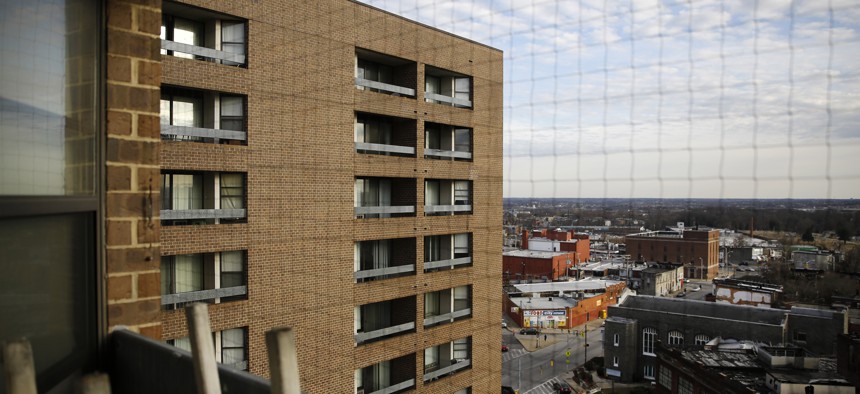Biden Infrastructure Plan Offers $213 Billion ‘Sweeping Investment’ in Affordable Housing

This Feb. 26, 2019, photo shows Rosemont Tower in Baltimore from a resident's balcony. Health and safety inspectors gave the 200-unit public housing high-rise a failing score of 25 out of a possible 100 in 2017 and then last year a score of 71. AP Photo/Patrick Semansky
The president’s proposal calls for $40 billion to improve existing public housing, as well as funding for grants and tax credit programs to build and preserve affordable units.
President Biden’s infrastructure plan would provide $213 billion for affordable housing, a “tremendous” investment according to advocates that would help modernize public housing and encourage local governments to do away with zoning practices that limit affordability.
Many of the plan’s details are yet to be determined, including how various grants and tax credits would be used and what levels of government would administer them. But affordable and public housing advocates say the administration’s funding commitments go far beyond what have been proposed in the past to address the U.S. affordable housing crisis.
Of note is the $40 billion that Biden’s plan would set aside for improving infrastructure in the existing public housing system. Estimates for the level of repairs and investment needed to modernize and fix structural deficiencies are more than $70 billion, said Sunia Zaterman, executive director of the Council of Large Public Housing Authorities, so the Biden plan would address some but not all of need.
“No one to date has proposed that kind of sweeping investment,” Zaterman said of the proposal.
The United States has a shortage of nearly 7 million affordable rental homes for low-income renters, according to a recent report from the National Low Income Housing Coalition. No state or major metropolitan area has enough affordable housing to meet the needs of its poorest renters, leaving 70% of low-income renters to spend more than half of their income on housing, according to the report.
While light on details, a fact sheet laying out the broad scope of Biden’s plan said the administration aims to preserve, build and retrofit more than 1 million affordable housing units through “targeted tax credits, formula funding, grants, and project-based rental assistance.”
“If it’s spent right, it could be very meaningful to ending homelessness in this country,” said Diane Yentel, the president and CEO of the National Low Income Housing Coalition. “There are not a lot of details in how that will be spent, and the details really matter.”
Depending on the type of grants used, state and local governments could see significant opportunities for investment in local housing stock, advocates said. They point to the national Housing Trust Fund, which provides grants to states, and Community Development Block Grants, which provides annual grants on a formula basis to states, cities and counties to develop housing, as possible vehicles for distributing affordable housing funds.
One area where Biden’s infrastructure plan does get into specifics is in advocating for adoption of the Neighborhood Homes Investment Act. The act would provide $20 billion in tax credits to help fund the construction or rehabilitation of more than 500,000 homes in neighborhoods with low property values or housing in poor condition. The act would provide tax credits over five years to help homeowners cover the gap between the cost of development or rehabilitation and the sales price of a home.
The Biden proposal also looks to take on the issue of exclusionary zoning laws, which could include prohibitions on multifamily housing or minimum lot sizes. Local governments have used such laws to block or limit affordable housing in wealthy neighborhoods, instead concentrating low-income or multifamily housing in poor neighborhoods. These types of prohibitions can lead to limited housing stock and in turn drive up housing costs, Yentel said.
The Biden plan calls on Congress to adopt a competitive grant program that awards funding to jurisdictions “that take concrete steps to eliminate such needless barriers to producing affordable housing.”
By conditioning funding to new grants, the administration’s plan will be more likely to stave off fights with local governments that do not want to alter their zoning rules, Yentel said.
“Zoning is primarily a local decision, but there are incentives that can be tied to federal funds so that if a community wants to receive a pot of money from the federal government they have to reverse restrictive zoning,” she said.
Andrea Noble is a staff correspondent with Route Fifty.
NEXT STORY: Pandemic accelerated rise of smart cities





